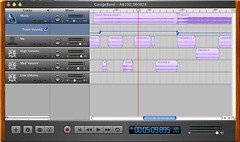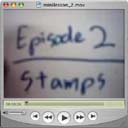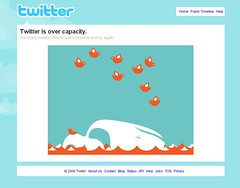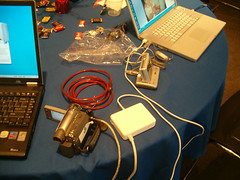It occurs to me that I posted this here and here, but totally neglected to put it on my own site. Oh well.
If you haven’t seen my latest creation yet, here it is. I’m hoping to record part 2 (or more, time permitting) this weekend.
It occurs to me that I posted this here and here, but totally neglected to put it on my own site. Oh well.
If you haven’t seen my latest creation yet, here it is. I’m hoping to record part 2 (or more, time permitting) this weekend.
Warning: The following podcast contains words which, when placed in a particular order, can be used to convey ideas. People who are set in their ways should listen at their own discretion.
 So this weekend I actually got caught up on my audio podcasts. This was no small achievement, as I had several gigabytes of downloaded but unplayed podcasts on my hard drive before I went to the DEN National Institute, and while there I didn’t really listen to any of them until after I got back home.
So this weekend I actually got caught up on my audio podcasts. This was no small achievement, as I had several gigabytes of downloaded but unplayed podcasts on my hard drive before I went to the DEN National Institute, and while there I didn’t really listen to any of them until after I got back home.
That being said, I still have 43 video podcasts waiting for me to watch them. There was a time when video podcasting was unheard of, due to a combination of bandwidth, storage, and equipment costs. Times have changed since then, and while audio podcasts still outnumber their video cousins, there seem to be a lot more .mp4 files showing up in my podcatcher these days.
Unfortunately for me, my method of experiencing these podcasts hasn’t changed much at all. I mostly play them when I’m in the car, playing video games, doing dishes, researching art lessons, folding laundry, and playing video games – you know, activities where my eyes are required to be actively engaged in something other than watching video. It’s this ability to multi-task that drew me in part to podcasting in the first place.
But with video – good video – your attention is demanded. You might still be able to multi-task, but as you can’t look at two things as well as one you’ll always be missing something.
And that’s my inspiration for this episode – a comparison of the pros and cons of video and audio formats.
Cost
 Audio podcasts have a much lower entry cost, both for creating them and carrying them on portable devices. I can spend $50 or less and get a half decent mp3 player, but it won’t do video at that price. Add to that the fact that all I need is a phone to record an episode and I don’t even need a computer with a working microphone to get started.
Audio podcasts have a much lower entry cost, both for creating them and carrying them on portable devices. I can spend $50 or less and get a half decent mp3 player, but it won’t do video at that price. Add to that the fact that all I need is a phone to record an episode and I don’t even need a computer with a working microphone to get started.
Video podcasts have gotten cheaper over the years (due in no small part to the iPod’s video capabilities and competitors’ desire to give more value for a lower price), with portable video players selling for $100 or less. Recording equipment is coming down in price too, with decent digital video cameras selling for $200 or less. Digital still cameras are actually able to record half decent video nowadays, and let’s face it, lots of laptops have built in cameras so you might not even have to buy anything new at all.
Work Load
Audio is, in my opinion, easier to edit than video. A lot easier. I can very easily remove hums, haws, ers, ums, yawns, and so on without the listener ever knowing those things were in there, provided there are no visual cues. When I cut something out of video using the same process, you notice. Yes, there are ways to cover these things up, but they’re not as simple to do as the tried and true “select, delete, and move on” method of editing audio.
Of course I suppose you could always go with the “I don’t edit my podcasts” method that some people have adopted, but I’m not willing to go there … yet.
Multi-Tasking
I’ve already covered this a little bit. When recording or listening to audio, it’s very easy to be doing something else at the same time. With video this is only possible if you don’t care much for at least one of the things that’s demanding your attention, and I for one don’t want to put the extra work into a video podcast if no one’s going to watch it.
Wow, I’m really hammering the video format in this episode, aren’t I? With all of these drawbacks, is there any reason to choose video over audio? You bet there is!
Multiple Learning Styles
 Using an audio only format appeals the most to people who learn that way, but some of us (myself included) are visual thinkers. We can still digest information by hearing it, but it’s so much easier if you show us as well.
Using an audio only format appeals the most to people who learn that way, but some of us (myself included) are visual thinkers. We can still digest information by hearing it, but it’s so much easier if you show us as well.
And by “show,” I mean it. Talking heads add very little to a presentation, but you can still insert slides from a PowerPoint, images of examples, and the like to keep your viewer’s interests. It’s true that many of the video podcasts I’ve made myself had that very problem (even if the times I waxed theatric helped a little bit), but I eventually came to realize that my audience wasn’t getting much more out of it through the video I was including.
That’s why I’m back to audio only for the most part, saving video for special occasions. I think the only reason I got away with what I was doing was because video podcasts were still somewhat new at the time, and the “wow, this is new!” factor gave me a bit of an edge.
The problem is, newness doesn’t last.
Now there are people out there that are doing it right. If you ever get a chance to see one of Lawrence Lessig’s presentations you’ll see what I mean. They’re simple, true, but every slide reinforces the message he’s trying to convey.
A recent presentation on the culture of YouTube (found via Will Richardson) would make another excellent, if a bit long, video podcast. There’s a lot of talking heads in it, but the scenes are varied, mixed with images and video from a variety of sources, and even the inserted still images move across the screen in a way to support his message.
Warning: If you’re sick of hearing about micro-blogs like Twitter, Pownce, Jaiku, and Plurk, today’s podcast might not be for you.
 Those of you who’ve been listening for a while (at least since show 128) may recall how enthusiastic I was over a website called Twitter. I found micro-blogging to be incredibly addictive in spite of its 140 character limit because the conversations were worthwhile. I quickly established a PLN (or Personal Learning Network) of fellow educators and thoroughly enjoyed the learning (and joking around) that ensued.
Those of you who’ve been listening for a while (at least since show 128) may recall how enthusiastic I was over a website called Twitter. I found micro-blogging to be incredibly addictive in spite of its 140 character limit because the conversations were worthwhile. I quickly established a PLN (or Personal Learning Network) of fellow educators and thoroughly enjoyed the learning (and joking around) that ensued.
Then Jaiku came along, and I hoped with all my heart that the people in my PLN would all jump ship and move over to there. Alas, while some did, most didn’t bother, so I eventually abandoned Jaiku and reluctantly returned to Twitter.
Fast forward to the creation of Pownce, and history repeats itself.
I loved Pownce for many reasons, most of which I won’t go over here. Its coolest feature however was the ability to have threaded conversations. Reading through the posts of everyone I’m following on Twitter is like standing in the middle of a crowded room. You hear snippets, but not always a complete conversation.
Ok, usually not. The problem was while I would often see people responding to other Twitter-ers, I wouldn’t see what was being responded to unless I was also following that other person. Through the creative use of putting “@” in front of user names I could find that individual, but if they were prolific with their tweets then it would still be hard to follow the conversation.
 And remember, it was conversations that made Twitter cool in the first place.
And remember, it was conversations that made Twitter cool in the first place.
The best way to solve this seemed to be following everyone that everyone else in my PLN followed, but there is a physical and mental limit to how many people I can follow so I merely replaced one problem with another.
I still think Pownce is among the best micro-blog formats out there, but the only times my PLN moved over there were when Twitter was down. Granted, that meant they were there a lot, but never to stay. Most conversations on Pownce could be summarized as follows:
“Oh, Twitter’s down again.”
“Is Twitter up yet?”
“No. It’s so annoying that it’s down so often.”
“I know! I’m about ready to – hey, it’s back up!”
And that’s the last I would see of them on Pownce until the next Twitter outage.
So once again, I abandoned a better service for Twitter. As much as I liked Pownce, I had to stay with my PLN.
 And then came Plurk.
And then came Plurk.
Plurk has a few annoying things about it, most notably a lack of text messaging support and a right-to-left scrolling “timeline,” but every post can receive threaded responses so my main problem with Twitter is already solved.
Plurk also has something called “karma.” This has nothing to do with reincarnation, it’s simply a score for how well you’re interacting with others. I’m not too certain about the algorithm used, but I do know that your score goes up more for posting only a few “plurks” that generate responses from others than it does from posting 1,000 “plurks” and getting few, if any, responses. Your karma can go up as you gain followers, but the method I’ve seen on Twitter of going through and following hundreds of people in an attempt to get them to follow you in return will actually hurt your score.
That’s something cool that I didn’t expect to see in a micro-blog. In my opinion one of the cancers of Web 2.0 sites has been the large number of people who treat it as simply a game where whomever has the most followers wins. I’d first heard of this happening on MySpace when a friend complained that her brother had more “friends” than she did, even though he didn’t really know most of them and she knew all of hers. (I think she wanted me to create an account so her score would go up by one … I still didn’t.) I’ve since seen this problem on Facebook, Twitter, Jaiku, YouTube, and even to a limited extent on Pownce.
But I’ve yet to see it on Plurk. They’ve essentially replaced one score, your number of followers, with another score, karma. There are still ways to game the system, I’m sure, but I’m not getting 20 friend requests a day from people who are already following over 1,000 others on this service, and I like it better that way. (I often block those people when I see them on Twitter.)
On top of that, Plurk’s karma score encourages more meaningful conversation than Twitter did. Posts itemizing everything you’re doing from minute to minute can actually lower your score, as you won’t get many responses to “Hey, I just made some hashbrowns.”
Plurk also has something else: Steve Dembo. Steve’s taken a liking to Plurk himself, and as a result many of those in my PLN have either made the switch or are now active in both. My one reason for staying on Twitter is gone. If I check only Plurk I feel that I have a sufficiently large and knowledgeable PLN.
Or do I? There are enough people who haven’t made the switch to make me wonder, so I did a little three-part assessment of my PLNs on both services. Using Ping.fm I posted to both sites simultaneously, setting up a series of hoops to jump through.
Round 1: “Is this thing on?”
 This was simply to test the waters to see who was not only listening, but willing to respond. I wasn’t too surprised that my first response came from someone on Twitter – after all, I have more followers there, so at any given time it’s more likely that someone’s loading their Twitter client right after I’ve posted something. What Twitter didn’t have was staying power. Responses there tapered off after only 6 responses out of 273 followers.
This was simply to test the waters to see who was not only listening, but willing to respond. I wasn’t too surprised that my first response came from someone on Twitter – after all, I have more followers there, so at any given time it’s more likely that someone’s loading their Twitter client right after I’ve posted something. What Twitter didn’t have was staying power. Responses there tapered off after only 6 responses out of 273 followers.
Plurk, on the other hand, had 18 different people respond out of a smaller pool of 68 followers, some of them responding more than once.
These numbers included some people who were unbiased and used both services, and therefore responded using both services.
It should be noted that when I posted the round 1 results, at least two people on Twitter complained and more than one person on Plurk thought the result was very unexpected.
Round 1 Winner: Plurk
Round 2: “I have a question.” (a: Work b: Play)
 One of the reasons for having a PLN is to use it as a resource when looking for answers. With that in mind, I asked two questions. The first one asked for useful online tutorials for the free, open source Photoshop replacement known as GIMP. Responses were limited to one on each side, but the one from Twitter was to a page that listed multiple tutorial sites, including the one that the Plurk responder provided.
One of the reasons for having a PLN is to use it as a resource when looking for answers. With that in mind, I asked two questions. The first one asked for useful online tutorials for the free, open source Photoshop replacement known as GIMP. Responses were limited to one on each side, but the one from Twitter was to a page that listed multiple tutorial sites, including the one that the Plurk responder provided.
My second question was for people to “waste my time” by letting me know what their favorite web-based games were. Chris Craft posted a creative game involving Google searches on Twitter, but on Plurk the same question got me two very well designed Flash games and one reference to building up one’s karma score. Oh yeah, and someone complaining that after they read the answers they wasted some of their own time playing those games.
On top of that the conversation in that thread continued on Plurk even after I posted the results, hammering in the solid win for Plurk.
Round 2 Winner: Tie (a: Twitter, b: Plurk)
Round 3: “Convince me.”
 For the third and final round I simply asked for people to tell me why their micro-blog of choice was better. I received just one answer on Twitter, though it was concerning Twitter’s compatibility with text messaging services so it was a darned good argument.
For the third and final round I simply asked for people to tell me why their micro-blog of choice was better. I received just one answer on Twitter, though it was concerning Twitter’s compatibility with text messaging services so it was a darned good argument.
On Plurk I had several responses, ranging from short and sweet to links to full-fledged blog posts on the subject.
Round 3 Winner: Plurk
So there you go, my take on the micro-blog battleground. I don’t expect Twitter to go away ay time soon, but apparently I’m getting a lot more out of Plurk than Twitter these days.
And hey, whether or not you agree with my somewhat subjective results, I’d love to hear your opinion in 140 characters or more. You could always leave a comment here, but I’d rather see you write your own blog post or record your own podcast on the subject. If you link back to me when you post it, I’ll be sure to see it when I search Technorati or Google.
 Academic Aesthetic 164: DEN NI 08
Academic Aesthetic 164: DEN NI 08
In today’s show I interview a bunch of people here at the Discovery Educator Network National Institute for 2008. (I decided to not put the full name in the title.) See how many faces you can recognize.
Also, my voice is giving out and I feel sick. Yay for conferences!
 Yes, THAT Discovery. They’re doing an ed-tech conference all this week and I’m along for the ride.
Yes, THAT Discovery. They’re doing an ed-tech conference all this week and I’m along for the ride.
You can be too, if you want. Most of the content I’m collecting can be found either on my Flickr acount or my Plurk acount. You don’t need to sign up for those to follow along, but they’re fun and free if that floats your boat.
The following was written back in June, but I’ve been sitting on it until now because I wanted to be able to take a step back and look at my writing first before posting.
One would think that sleeping until noon would be one of life’s simple pleasures afforded to teachers during the summer months. While I’ve nothing against prolonged inspection of the backs of my eyelids, I’m still dragging myself out of bed at 5:30 AM at least three days a week to help my wife get ready for dialysis.
 I won’t go into any great detail on her medical condition here (that’s a subject for a different podcast), but it does leave me with several hours of alone time while she goes through the procedure. On days when I drive her to the dialysis center, gas prices are high enough for it to not make sense for me to drive home and back – making my period of solitude also one where I lack any ability to contact the internet. (UPDATE: I’ve since purchased a BlackBerry Curve, so now my addiction to the internet has reached the next level.)
I won’t go into any great detail on her medical condition here (that’s a subject for a different podcast), but it does leave me with several hours of alone time while she goes through the procedure. On days when I drive her to the dialysis center, gas prices are high enough for it to not make sense for me to drive home and back – making my period of solitude also one where I lack any ability to contact the internet. (UPDATE: I’ve since purchased a BlackBerry Curve, so now my addiction to the internet has reached the next level.)
Now granted, I’ve been incredibly lax in posting things on this site. I could go through lots of excuses, but the one I think I’ll stick with is that it’s a lot harder for me to do one of these entries when I’m not online, even though I feel most inspired when I can’t get online.
Usually when I’m writing out my scripts I’ll have three or four tabs open for reference purposes. Either I’m responding to someone else’s blog post, or linking to another site that further explains a concept, or even looking for just the right picture to insert into the entry. I can’t do any of these things without the internet at my fingertips.
But here I am in my car, in just such a situation. I can do whatever I want, so long as I only use the software and files in my little magic box. Cloud computing? Ha! That’s no good to me here.
 This very much reminds me of a job interview I went to a few weeks ago. The position was for teaching technology to students and teachers in a Pre-K through 5th grade school, something that on the surface is really right up my alley. Still, I went in with more questions for them than they had for me.
This very much reminds me of a job interview I went to a few weeks ago. The position was for teaching technology to students and teachers in a Pre-K through 5th grade school, something that on the surface is really right up my alley. Still, I went in with more questions for them than they had for me.
And everything I encountered made it look like a dream job come true. The school was fairly new, so there weren’t any old computers on the verge of breaking down. The computer lab, the ceiling mounted LCD projectors in every class, the three (THREE!) mobile labs that teachers actively fought over, the school-wide wi-fi, everything about it looked awesome.
Everything, until near the end of my visit when I started asking about wikis, blogs, and podcasts.
Oh, they don’t do those.
In fact, anything that remotely resembles a blog or wiki is actively blocked. The school administration was very forward thinking, but the district had adopted a “walled garden” approach that would have prevented me from visiting even my own website from school.
 Contrast this with my current employer, which isn’t throwing as much cash into tech programs but is actively encouraging teachers to use resources available to them on the internet – including workshops on blogging, podcasting, and wikiing.
Contrast this with my current employer, which isn’t throwing as much cash into tech programs but is actively encouraging teachers to use resources available to them on the internet – including workshops on blogging, podcasting, and wikiing.
“Wikiing?” Is that a word? Nevermind.
Long story short(er), I’m not pursuing the job. I only went to the interview because it sprung up at the last moment, and I felt I needed to dust the cobwebs off of the old portfolio. With the way technology is advancing, and the skills that I see successful people using right now, I feel I could do more to prepare kids for the real world with a lab of salvaged computers running linux and my current employer’s filtering policy than all the high tech gadgetry in the world but no way to use it properly.
Because while the tech is cool, it’s really not about the tech. It’s about communication. It’s about collaboration.
And it’s about teaching students how to use these things responsibly, because locking kids in their rooms for fear that they’ll go to the mall and something scary will happen will not prepare them for when they finally move out and go there themselves. Instead, we should take them there, hold their hands at first, and show them how to react in that environment.
Anything else is a disservice to the generation that will be running our nursing homes when we retire.
 Written during last Wednesday’s thunderstorm-induced power outage (which gave us off on Thursday…), and recorded during tonight’s thunderstorm, I talk a bit about how the “old” should not always be replaced by the “new.”
Written during last Wednesday’s thunderstorm-induced power outage (which gave us off on Thursday…), and recorded during tonight’s thunderstorm, I talk a bit about how the “old” should not always be replaced by the “new.”
Back when I taught high school, I was often in buildings that were fed by middle and elementary schools that did not hold art education in high esteem. This meant that I had to tailor my lessons to cover things most students learn in their K-8 years but make them interesting for a high school audience.
It also meant that I was able to make a list of things that, once I eventually taught elementary, would be able to drill into my students to prevent premature baldness and graying amongst the high school art teachers.
This list included the following five things:
 People are not sticks. (I don’t mind if a 3rd grader tries to draw a person and it doesn’t turn out, but a 3rd grader drawing a stick figure isn’t even trying.)
People are not sticks. (I don’t mind if a 3rd grader tries to draw a person and it doesn’t turn out, but a 3rd grader drawing a stick figure isn’t even trying.)Granted, I didn’t cover these things in every grade and every lesson. Not all students are developmentally able to comprehend my little list, and I still have room in my curriculum to do lessons that are more fun than they are nitpicky.
But at least by the time they leave elementary school all of my students know:
My official curriculum is much more detailed than this, but I suppose these items are my “pet peeves,” if you will.
And this sort of got me thinking: Since I might become a technology teacher in a couple years, how will my list change? What are my technology pet peeves that I’ll feel I must cover, above and beyond the official standards?
I came up with something like this:
Well, that’s my list, at least. What’s yours?
Wow, 160 … that’s almost a milestone, isn’t it? I suppose I should take the time to try out something new then, huh?
In any case, here’s a quick rundown on my opinions concerning Flickr’s decision to host videos:
 This story, as horrible as it is, ends with a very misleading quote at the end.
This story, as horrible as it is, ends with a very misleading quote at the end.
Herrera said the violence could have been prevented if the school had enforced its cell phone ban.
I think this quote points at the wrong issue. Yes, the student used her cell phone to call her mom into the school and solve her issues with violence, but she could have also told her mom once she got home from school. The cell phone only sped up the process.
I see 2, maybe 3 issues here – none of which are centered on cell phones.
Is it too much to ask that a news story portraying an all-around-bad situation not have anything in it that blames the technology along with (or instead of, in some cases) the people using it?